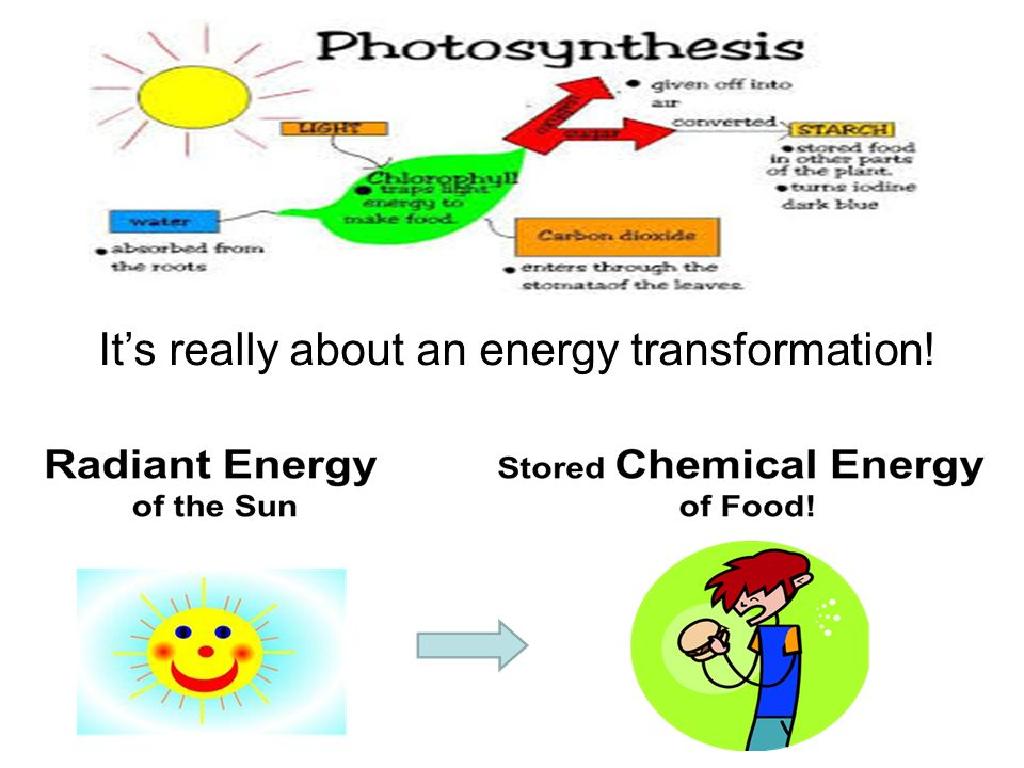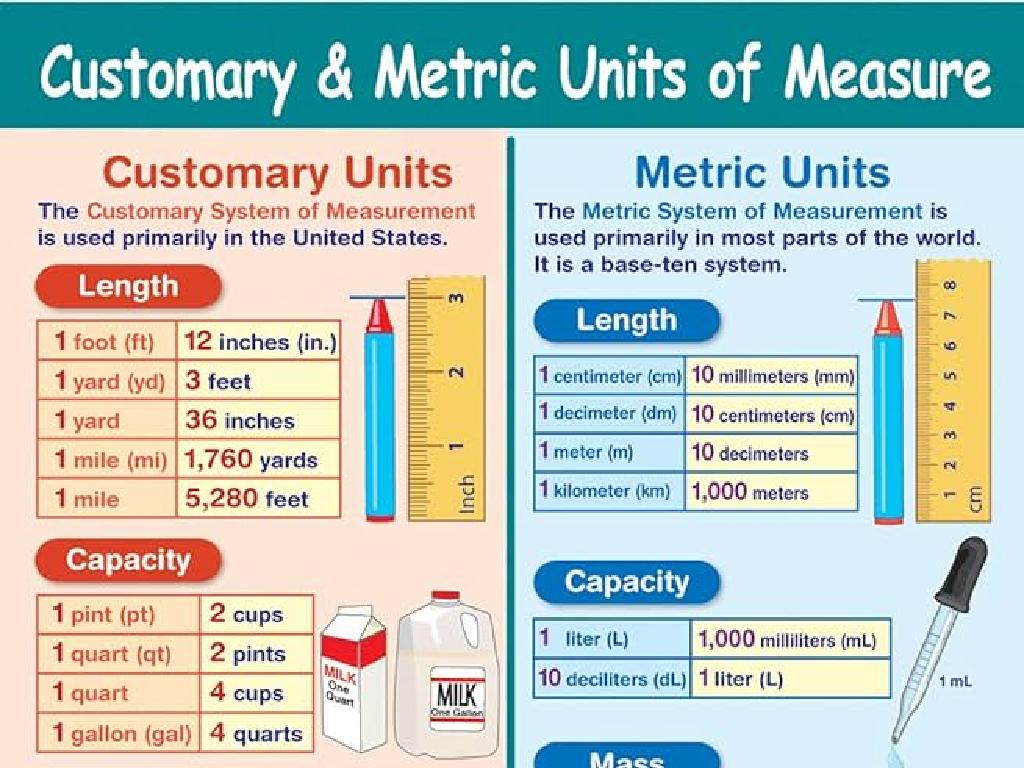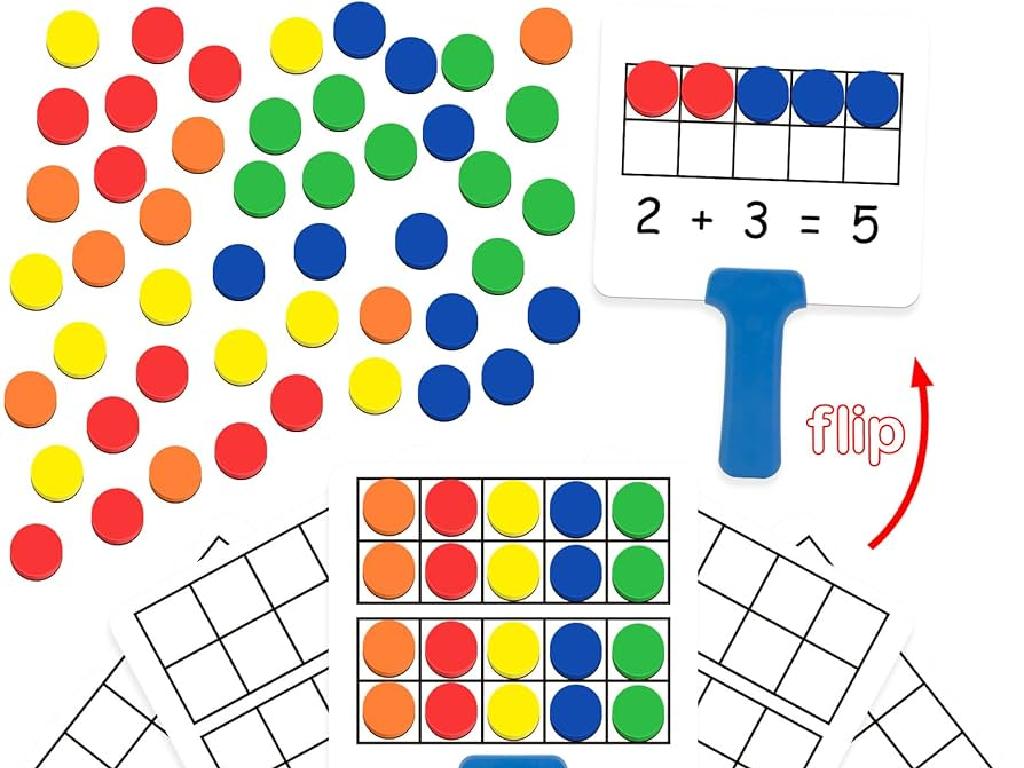Match The Contractions
Subject: Language arts
Grade: Third grade
Topic: Contractions
Please LOG IN to download the presentation. Access is available to registered users only.
View More Content
Getting to Know Contractions
– What are contractions?
– A contraction is a shortened form of two words, like ‘do not’ to ‘don’t’.
– Why use contractions?
– They make speaking and writing quicker and more informal.
– Examples: I’m, you’re, we’re
– ‘I am’ becomes ‘I’m’, ‘you are’ turns into ‘you’re’, ‘we are’ changes to ‘we’re’.
– Practice with contractions
|
This slide introduces the concept of contractions to third-grade students. Begin by explaining that contractions are a way to combine two words into one shorter word, making it easier and faster to speak and write. Emphasize that contractions are often used in everyday conversation and informal writing. Provide clear examples of common contractions and ensure students understand how they are formed. Encourage students to think of other examples and to practice creating contractions from full phrases. This will prepare them for an activity where they will match contractions with their expanded forms.
Creating Contractions
– Making a contraction: combine words
– Join two words to make one shorter word
– Use an apostrophe for missing letters
– An apostrophe shows where letters are left out
– Practice example: Let us Let’s
– ‘Let us’ is shortened to ‘Let’s’ by replacing ‘u’ with ‘ ‘
|
This slide introduces the concept of contractions to third-grade students. Explain that a contraction is a shorter way to say two words. Show how an apostrophe is used to take the place of the missing letters. For example, ‘do not’ becomes ‘don’t’, where the apostrophe replaces the ‘o’ in ‘not’. Use the practice example to illustrate the point: ‘Let us’ can be contracted to ‘Let’s’, where the apostrophe shows that the ‘u’ has been removed. Encourage students to think of other examples and practice creating contractions from them. This activity helps students understand how contractions are formed and prepares them for identifying and using contractions in their writing.
Contractions with ‘not’
– Learn ‘not’ contractions: can’t, don’t, won’t
– ‘Can’t’ is short for ‘cannot’, ‘don’t’ for ‘do not’, ‘won’t’ for ‘will not’
– See them used in sentences
– ‘I can’t swim’, ‘We don’t have school today’, ‘She won’t come to the party’
– Activity: Matching contractions
– Match ‘cannot’ with ‘can’t’, ‘do not’ with ‘don’t’, ‘will not’ with ‘won’t’
|
This slide introduces students to contractions with the word ‘not’. Focus on explaining that contractions are a shorter way to say two words, like ‘can’t’ for ‘cannot’. Use clear examples in sentences to show how these contractions are used in everyday language. For the activity, provide students with a list of full forms and contractions on separate cards and ask them to match them. This interactive activity will help reinforce their understanding of contractions. Possible variations of the activity could include a worksheet with columns to match, a game where students find their match among their classmates, or a drawing activity where they connect the words with a line.
Contractions with ‘is’ and ‘has’
– ‘is’ contractions: he’s, she’s, it’s
– he’s can mean he is or he has
– ‘has’ contractions: he’s, she’s, it’s
– she’s can mean she is or she has
– Understanding ‘s: ‘is’ vs. ‘has’
– Context tells us if ‘s means ‘is’ or ‘has’
– Practice with examples
– ‘He’s won’ vs. ‘He’s happy’
|
This slide introduces students to contractions with ‘is’ and ‘has’, focusing on ‘he’s’, ‘she’s’, and ‘it’s’. It’s crucial to explain that ‘s can stand for both ‘is’ and ‘has’, and context determines the meaning. Provide examples to illustrate the difference: ‘He’s won’ shows ‘has’ because it indicates possession of a win, while ‘He’s happy’ uses ‘is’ to describe his state of being. Encourage students to practice by creating sentences with both meanings for each contraction and to share their sentences with the class. This will help them grasp the concept of contractions and their correct usage in writing and speaking.
Contractions with ‘will’ and ‘would’
– ‘will’ contractions: I’ll, you’ll, they’ll
– I will = I’ll, you will = you’ll, they will = they’ll
– ‘would’ contractions: I’d, you’d, they’d
– I would = I’d, you would = you’d, they would = they’d
– Match contractions to context
– Use sentence clues to pick ‘will’ or ‘would’
– Practice with examples
– ‘I’ll go to the park.’ vs. ‘I’d go if it’s sunny.’
|
This slide introduces students to contractions with ‘will’ and ‘would’, which are shortcuts we use in writing and speaking. Students should understand that ‘I’ll’ is a contraction for ‘I will’, and similarly for ‘you’ll’ and ‘they’ll’. For ‘would’, ‘I’d’ stands for ‘I would’, and the same pattern follows for ‘you’d’ and ‘they’d’. It’s crucial to teach students how to use context to determine whether to use ‘will’ or ‘would’ in a sentence. Provide examples and create practice sentences where students can apply their understanding by choosing the correct contraction based on the context. Encourage them to explain their choices to develop a deeper understanding.
Contraction Matching Game
– Let’s play a matching game!
– Match phrases to contractions
– Connect ‘do not’ with ‘don’t’
– Work with a partner
– Pair up to combine your knowledge
– Find correct matches together
– Cheer each other on as you discover matches
|
This slide introduces a fun and interactive matching game where students will work in pairs to match full phrases with their corresponding contractions. The activity is designed to reinforce their understanding of contractions in a collaborative and engaging way. Teachers should prepare a list of common contractions and their full forms prior to the class and have them ready for the activity. During the game, circulate around the room to assist pairs as needed and ensure that each pair is participating and on task. After the activity, review the matches as a class to solidify learning. Possible variations of the game could include a timed challenge, a competition to see which pair finds the most matches, or using flashcards to facilitate the matching.
Class Activity: Contraction Creation
– Learn to make contractions
– Choose two words to combine
– Create your own contraction
– For example, ‘do not’ becomes ‘don’t’
– Share with the class
|
This activity is designed to help students understand and practice forming contractions, which are shortened forms of word pairs. Students will select two words that can be combined into a contraction and then share their creations with the class. This exercise encourages creativity and participation while reinforcing the lesson on contractions. As a teacher, be prepared to guide them through the process, ensuring they understand which letters are omitted and how the apostrophe is used to replace them. Have a list of common word pairs ready for students who may need a starting point, and be ready to celebrate all the new contractions they come up with!
Review and Practice: Contractions
– Review today’s contractions
– Go over the list of contractions we learned
– Practice contractions in sentences
– Write sentences using ‘can’t’, ‘won’t’, ‘I’ll’, etc.
– Get ready for a contractions quiz
– Study for a fun quiz on what we’ve learned
|
This slide is aimed at reinforcing the students’ understanding of contractions. Begin by reviewing the contractions covered in today’s lesson, ensuring that students can recall and match them correctly. Move on to applying this knowledge by having students create their own sentences using contractions, which will help solidify their grasp of the concept. Finally, inform the students about the upcoming quiz and encourage them to study the contractions. Provide them with a study guide or a list of contractions to take home. The quiz will serve as a fun way to assess their learning and retention of the topic.
Wrapping Up Contractions
– Congratulations on learning contractions!
– Homework: Craft 10 sentences with contractions
– Use ‘I’m’, ‘can’t’, ‘we’ll’, etc. in sentences
– Use contractions in daily talks
– Try ‘don’t’, ‘isn’t’, ‘you’re’ when speaking
– Practice makes perfect!
|
This slide is meant to congratulate the students on their hard work learning about contractions and to give them a homework assignment that will help reinforce their understanding. Encourage them to write sentences using a variety of contractions to demonstrate their grasp of the concept. Remind them to also practice using contractions in their everyday conversations, as this will help them become more comfortable with natural spoken English. Provide examples of contractions for them to use, and remind them that regular practice is key to mastering contractions.






